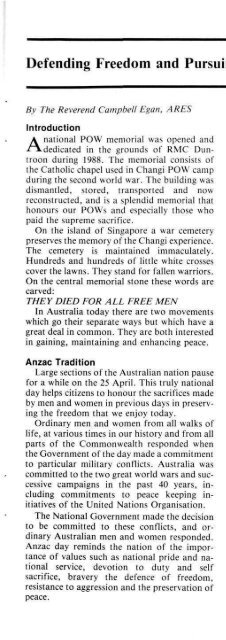ISSUE 75 : Mar/Apr - 1989 - Australian Defence Force Journal
ISSUE 75 : Mar/Apr - 1989 - Australian Defence Force Journal
ISSUE 75 : Mar/Apr - 1989 - Australian Defence Force Journal
- No tags were found...
Create successful ePaper yourself
Turn your PDF publications into a flip-book with our unique Google optimized e-Paper software.
10 DEFENCE FORCE JOURNAL No. <strong>75</strong> <strong>Mar</strong>ch/<strong>Apr</strong>il 89If we were to introduce a RM employmentstream in the ADF or Department there arefour specific matters that would need to be addressed.These are:Eligibility,Identification of suitable positions,Salary scales, andConditions of Employment.EligibilityThe first, and major difference, between theUK and an <strong>Australian</strong> proposal would berecognition of the valuable contribution whichWarrant Officers and Non Commissioned Officersmake to the overall effectiveness of theADF. To deny ourselves access that that considerablepool of talent residing in service personnelin their late thirties/early forties makesno economic sense. And moreover, to do otherwisereflects adversely upon those concepts ofleadership and 'man-management' upon whichthe Services pride themselves.An <strong>Australian</strong> RM employment streamshould therefore be open to those who haveheld those ranks between PO/SSGT/FSGT andCAPT(RAN)/COL/GPCAPT. Those belowthe rank of SSGT(E) would be unlikely to havethe range of experience and skills to fill positionswhere continuity is a significant factor.A further constraint would be to restrict entryto RM employment to members who havesatisfactorily completed a minimum period ofService in the Regular <strong>Force</strong>s: perhaps 21 yearsfor WOs and NCOs, up to 28 years for theCOL(E). Such a constraint would encouragemembers to complete a significant period ofRegular service without the fear of being tooold to obtain later employment.Identification of Suitable PositionsSuitable positions would need to be identifiedby the three Services. These would essentiallybe positions identified as 'non-combatant', inEstablishments where there is no significantchange of role between peace and war. ThoseEstablishments might include static headquarters(such as Russell Offices), storesdepots, training units, etc.There would be obvious incentives to the Servicesto identify the maximum number of positionsfor conversion to a RM stream: the Serviceswould reduce their military manpowercommitment while retaining military skills,there would be a reduction in the indirect costsassociated with employing military members(removal expenses, provision of marriedquarters, the military training of replacements),and they would be identifying positions inwhich there could be a vested long term selfinterest.Nor should the ADF/Department overlookthose positions which might previously havebeen civilianised and which are currently difficultto fill eg. the Technical Officer employmentcategory in the APS.On the basis of some preliminary calculationsthere would appear to be in the some 2500military positions throughout the ADF whichcould be filled by Retired Members, without inany meaningful way diminishing the operationalcapability of the ADF.Salary ScalesUnlike the UK scheme, the pay of RMsshould not be reduced by an amount equal totheir service pension, but nor should there betotal 'double dipping'. The RM salary scalesshould be tied to, but not be equal to, PublicService ASO grades. The ASO pay level shouldbe abated by an amount to reflect the fact thatthe RM is employed in a protected category, ie.in a position not open to public entry. It shouldhowever, still reflect that the RM possessesskills which a member of the APS could not beexpected to possess, and must also acknowledgethat the Service pension has already beenearned.The suggested abatement could vary by ASOgrade but might average around 33% of thepension after maximum commutation has beentaken. For a WO(E) that abatement would be inthe region of $4400 a year, while for aLTCOL(E) it would be around $5600 a year.The direct savings to the Department of<strong>Defence</strong> would be the abatement x the numberof RM positions, an estimated $13.5m eachyear. In addition, indirect savings would beworth a further $lm each year.The following indicative pay scales for RMgrades might form the basis for discussion.

















